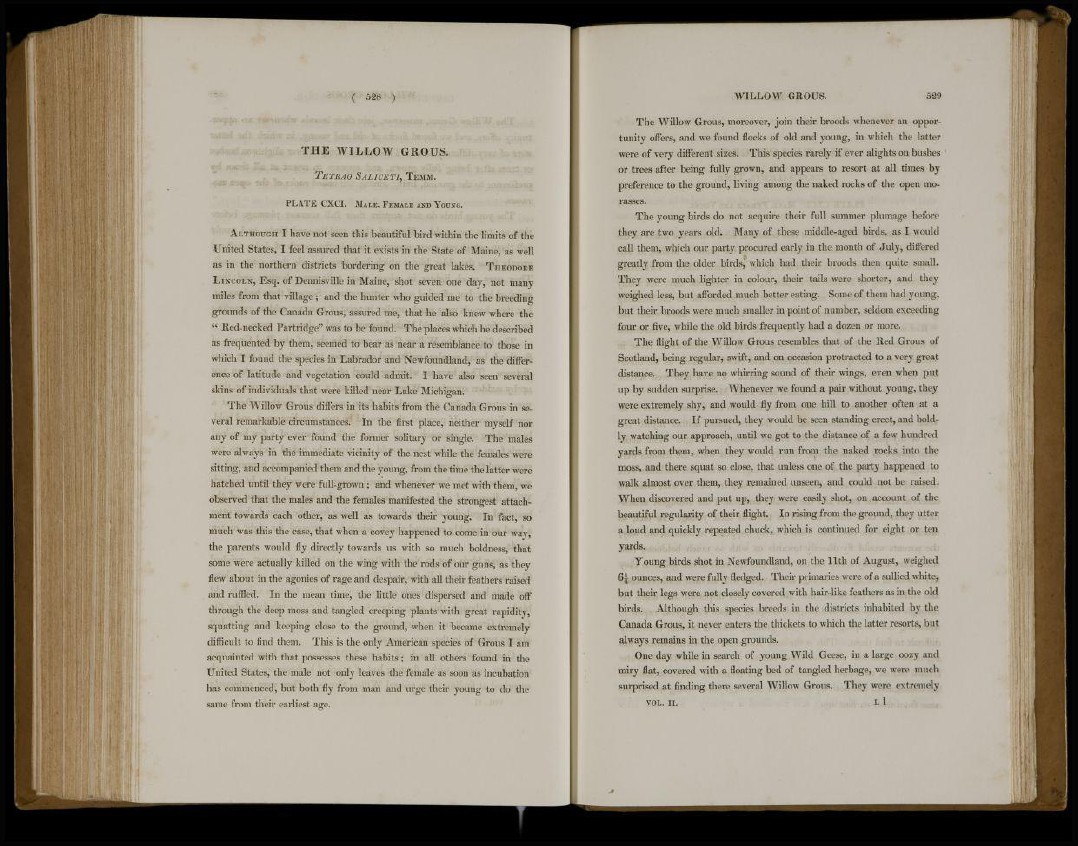
( 528 )
T H E W I L L O W G R O U S .
TETHAO S ALICE TI, TEMM.
P L A T E CXCI. MALE, FEMALE AND YOUNG.
ALTHOUGH I have not seen this beautiful bird within the limits of the
United States, I feel assured that it exists in the State of Maine, as well
as in the northern districts bordering on the great lakes. THEODORE
LINCOLN, Esq. of Dennisville in Maine, shot seven one day, not many
miles from that village ; and the hunter who guided me to the breeding
grounds of the Canada Grous, assured me, that he also knew where the
" Red-necked Partridge1' was to be found. The places which he described
as frequented by them, seemed to bear as near a resemblance to those in
which I found the species in Labrador and Newfoundland, as the difference
of latitude and vegetation could admit. I have also seen several
skins of individuals that were killed near Lake Michigan.
The Willow Grous differs in its habits from the Canada Grous in several
remarkable circumstances. In the first place, neither myself nor
any of my party ever found the former solitary or single. The males
were always in the immediate vicinity of the nest while the females were
sitting, and accompanied them and the young, from the time the latter were
hatched until they were full-grown ; and whenever we met with them, we
observed that the males and the females manifested the strongest attachment
towards each other, as well as towards their young. In fact, so
much was this the case, that when a covey happened to come in our way,
the parents would fly directly towards us with so much boldness, that
some were actually killed on the wing with the rods of our guns, as they
flew about in the agonies of rage and despair, with all their feathers raised
and ruffled. In the mean time, the little ones dispersed and made off
through the deep moss and tangled creeping plants with great rapidity,
squatting and keeping close to the ground, when it became extremely
difficult to find them. This is the only American species of Grous I am
acquainted with that possesses these habits; in all others found in the
United States, the male not only leaves the female as soon as incubation
has commenced, but both fly from man and urge their young to do the
same from their earliest age.
WILLOW GROUS. 529
The Willow Grous, moreover, join their broods whenever an opportunity
offers, and we found flocks of old and young, in which the latter
were of very different sizes. This species rarely if ever alights on bushes
or trees after being fully grown, and appears to resort at all times by
preference to the ground, living among the naked rocks of the open morasses.
The young birds do not acquire their full summer plumage before
they are two years old. Many of these middle-aged birds, as I would
call them, which our party procured early in the month of July, differed
greatly from the older birdsj which had their broods then quite small.
They were much lighter in colour, their tails were shorter, and they
weighed less, but afforded much better eating. Some of them had young,
but their broods were much smaller in point of number, seldom exceeding
four or five, while the old birds frequently had a dozen or more.
The flight of the Willow Grous resembles that of the Red Grous of
Scotland, being regular, swift, and on occasion protracted to a very great
distance. They have no whirring sound of their wings, even when put
up by sudden surprise. Whenever we found a pair without young, they
were extremely shy, and would fly from one hill to another often at a
great distance. If pursued, they would be seen standing erect, and boldly
watching our approach, until we got to the distance of a few hundred
yards from them, when they would run from the naked rocks into the
moss, and there squat so close, that unless one of the party happened to
walk almost over them, they remained unseen, and could not be raised.
When discovered and put up, they were easily shot, on account of the
beautiful regularity of their flight. In rising from the ground, they utter
a loud and quickly repeated chuck, which is continued for eight or ten
yards.
Young birds shot in Newfoundland, on the 11th of August, weighed
6 | ounces, and were fully fledged. Their primaries were of a sullied white,
but their legs were not closely covered with hair-like feathers as in the old
birds. Although this species breeds in the districts inhabited by the
Canada Grous, it never enters the thickets to which the latter resorts, but
always remains in the open grounds.
One day while in search of young Wild Geese, in a large oozy and
miry flat, covered with a floating bed of tangled herbage, we were much
surprised at finding there several Willow Grous. They were extremely
VOL. 11. L 1